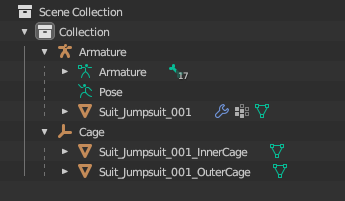Export your mesh or model as a .fbx or .gltf to take advantage of all of Studio's 3D import features. When rigging or skinning a layerable model, these file types contains all the mesh and texture data, including the rig and influence data, you need to later import into Studio.
Before exporting
Before exporting, ensure that you are only exporting the Roblox supported objects related to your model. If you have any modifiers to your mesh or project objects, make sure to apply or delete them before export.
You can export layered clothing models with the following object structure:

Armature parent
- Bones / joints
- Primary mesh object
Cage parent object
- Inner cage mesh object
- Outer cage mesh object
You can also export shoes together. Even though left and right shoes are separate accessories, you can either export the left and right shoe individually, or export both shoes at the same time using the following structure:

- Armature parent
- Bones / joints
- Left shoe mesh object
- Right shoe mesh object
- Cage parent object
- Left shoe inner cage
- Left shoe outer cage
- Right shoe inner cage
- Right shoe outer cage
Blender
Blender allows you to export in .fbx or .gltf as well as other formats. If you are using .fbx export, familiarize yourself with Blender's FBX scaling to ensure that you successfully import the model into Studio at the correct scale.
Export settings
To export the .fbx file in Blender:
In the topbar, click File. A pop-up menu displays.
Select Export, then FBX (.fbx). The Blender File View window displays.
On the right-hand side, change the Path Mode property to Copy, then toggle the Embed Textures button.

If your project doesn't already have .01 scene unit scaling, set the Transform > Apply Scalings to FBX Unit Scale. For more details, see Blender FBX scaling.

Under the Armature section, disable Add Leaf Bones.

Click the Export FBX button.
After exporting, use Studio's 3D Importer to import your model and the Accessory Fitting Tool to convert the model into an accessory.
Maya export settings
To export a mesh in Maya as a .fbx file:
- In the topbar, click File. A pop-up menu displays.
- Select Export All. The Export All window displays.
- Near the bottom of the window, click the Files of type dropdown, then select FBX export.
- On the right-hand side of the window, navigate to the Options... section.
- In the Geometry section, enable Smooth Mesh and Referenced Asset Content.
- If you need to import textures as a .png, in the Embed Media section, enable Embed Media.
- In the Advanced Options section,
- Navigate to Units, then enable Automatic.
- Navigate to Axis Conversion, then set the Up Axis property to Y.
- Click the Export All button.

- After exporting, use Studio's 3D Importer to import your model and the Accessory Fitting Tool to convert the model into an accessory.